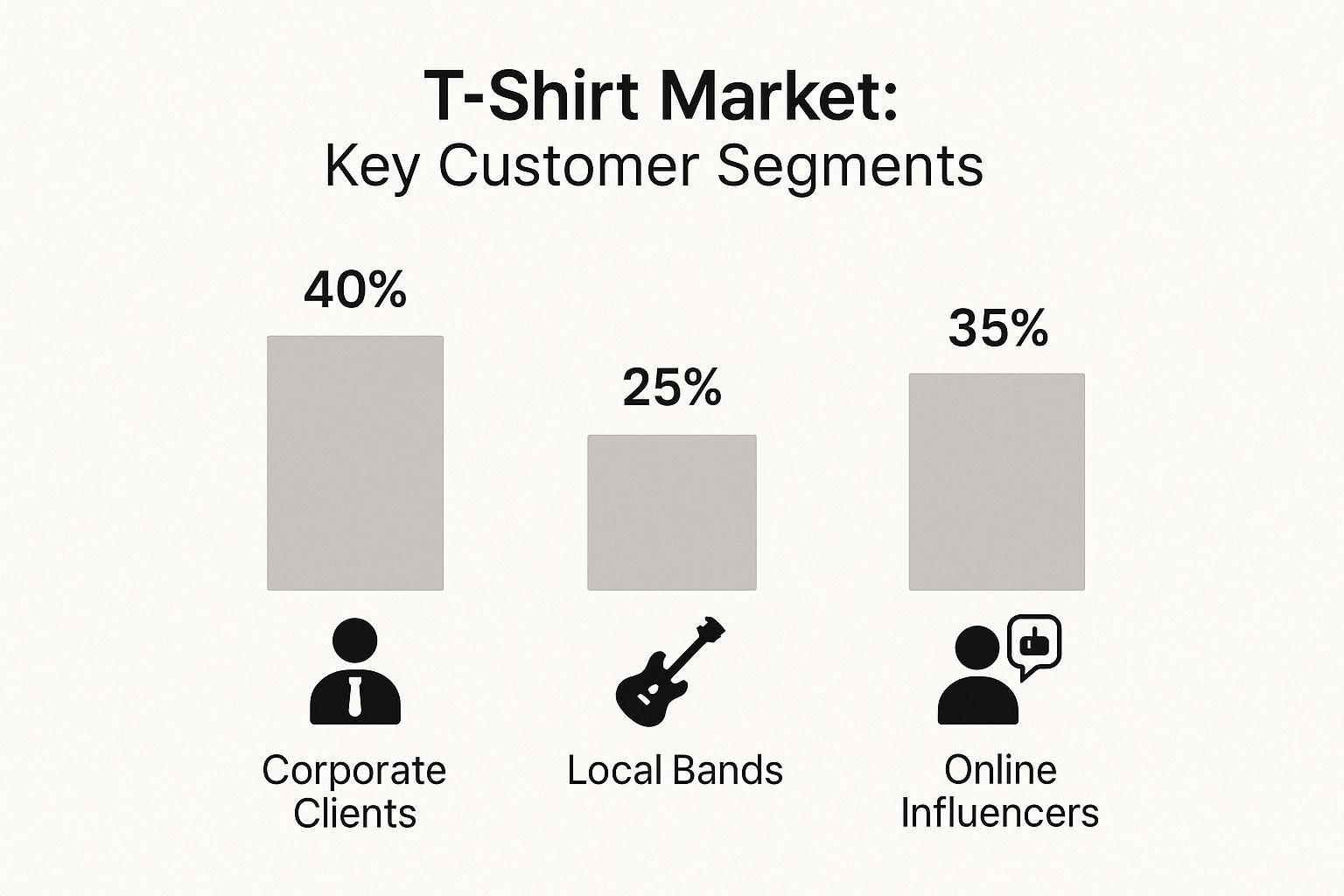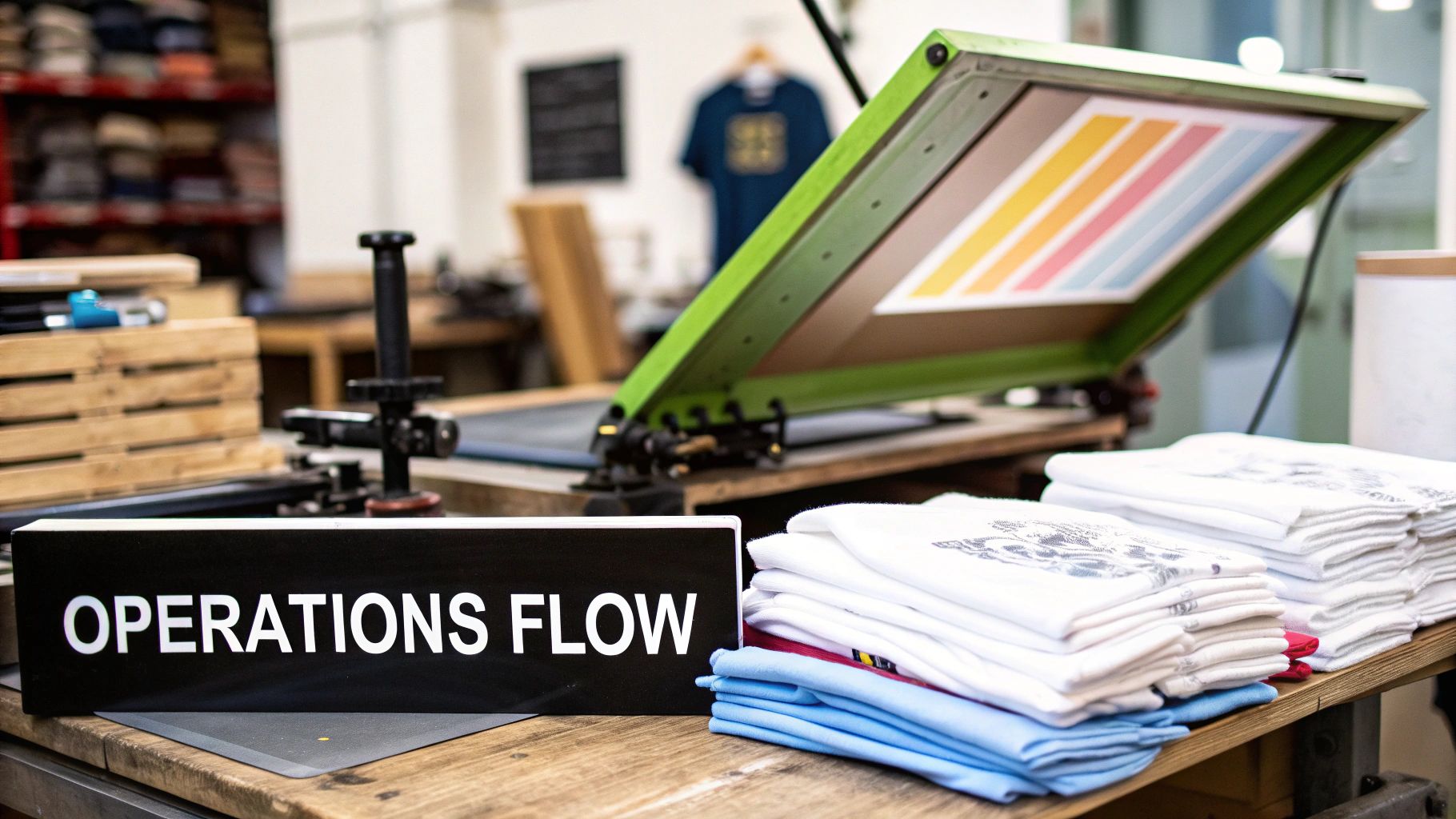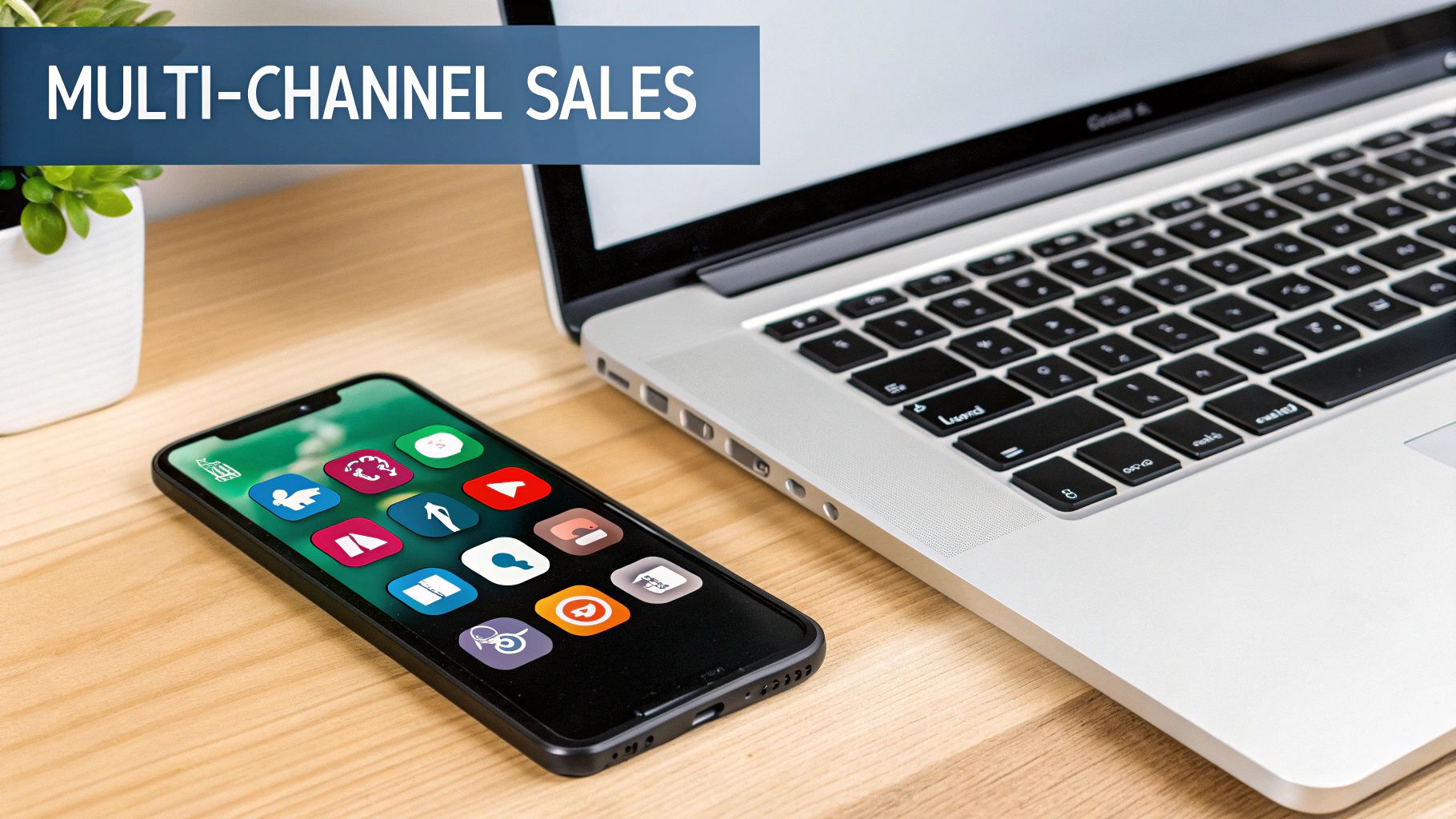
Create Your T Shirt Printing Business Plan
Share
Before you even think about firing up a heat press or ordering blank tees, you need a solid game plan. A t-shirt printing business plan is that plan—your strategic guide to launching and scaling an apparel brand that actually lasts. This isn't just paperwork; it’s a living document that turns your creative spark into a real, profitable business by mapping out your mission, who you're selling to, how you'll operate, and how you'll make money.
Building Your T-Shirt Business Foundation
Think of your business plan as the most critical asset you have before you've even printed a single shirt. Ditch the generic templates you find online. This document is your personal roadmap, forcing you to get brutally honest about your brand's purpose and how you’ll stand out in a ridiculously crowded market.
Getting this foundation right influences every single decision you'll make down the line—from choosing between DTF and screen printing to figuring out where your marketing dollars should go. It's the work that ensures you're building on solid ground, not sand.
Defining Your Mission and Vision
Your mission and vision aren't just fluffy corporate-speak; they're the soul of your brand. The mission is what you do right now and for whom. The vision is the future you're trying to build.
For example, a mission could be: "To empower local artists by printing their work on high-quality, eco-friendly apparel." The vision, then, might be: "To become the go-to platform for wearable art in our city."
These statements give your brand an identity and act as a magnet for the right kind of customers. A clear mission focused on sustainability, for instance, will naturally attract shoppers who care about the environment and will guide your decisions on everything from water-based inks to which blank apparel suppliers you partner with.
A well-defined mission is your business's compass. It doesn't just guide your internal decisions; it broadcasts your values to customers, building the kind of loyalty that goes way beyond a cool t-shirt design.
The timing couldn't be better. The custom t-shirt printing market is booming, thanks to a huge demand for personalized gear and leaps in printing tech. Valued at roughly $4.9 billion, the market is on track to hit $9.0 billion by 2033, growing at a steady 6.52% CAGR. A sharp business plan is what positions you to grab a piece of that pie.

Core Components of Your Business Plan
A truly effective t-shirt printing business plan needs to cover several key areas. Each section builds on the one before it, creating a complete picture of your strategy. If you need a deep dive into the whole process, this guide on how to write a business plan is a great resource.
Whether you're chasing investors or just creating a guide for yourself, this structure is crucial. It also forces you to decide on your fulfillment model—will you handle everything in-house or work with one of the many https://cobradtf.com/blogs/guides/print-on-demand-suppliers out there?
Here’s a quick-glance table breaking down the essential sections every t-shirt business plan needs.
Core Components Of Your Business Plan
| Component | Purpose | Key Questions to Answer |
|---|---|---|
| Executive Summary | A concise overview of the entire plan. | What is your business concept and what are your key goals? |
| Market Analysis | Details your target audience and competitors. | Who is your ideal customer and what market gaps exist? |
| Operations Plan | Describes your day-to-day workflow. | How will you source materials, print shirts, and fulfill orders? |
| Marketing Strategy | Outlines how you will attract customers. | Which channels will you use to promote your brand and products? |
| Financial Projections | Forecasts your startup costs, revenue, and profit. | What are your startup costs and when will you break even? |
Nailing each of these components will give you a clear, actionable strategy to follow as you launch and grow your business.
Finding Your Niche In The T-Shirt Market
Before you even think about buying a heat press, you need to know your battlefield. A solid t-shirt printing business plan is built on smart market analysis, not just trying to sell generic shirts to everyone. Trust me, being everything to everyone is a fast track to becoming nothing to anyone.
So, who are you printing for? Is it the local construction company that needs 100 branded safety-orange tees for their crew? Or are you designing limited-run merch for a popular indie band's upcoming tour? Maybe your sweet spot is creating those trendy, meme-inspired shirts that go viral on TikTok. Each of these paths is wildly different and dictates your designs, pricing, and how you find customers.
This quick breakdown shows you where the money often is in this business.

As you can see, corporate clients can bring in steady, high-volume work. But don't sleep on the smaller, passionate communities like bands or online creators—they can become your most loyal customers. The key is to figure out where you can make your mark.
Identifying Your Ideal Customer Profile
Stop guessing and start building a detailed profile of your perfect customer. This persona is the north star for every decision you make, from the kind of blank shirts you stock to the vibe of your Instagram feed. Demographics are just the start; you need to dig deeper.
Think about the real-life details:
- Interests and Hobbies: What do they love? Are they into tabletop gaming, CrossFit, urban gardening, or restoring vintage cars?
- Values and Beliefs: What do they care about? Maybe they only buy sustainable, eco-friendly products or they're passionate about supporting local community events.
- Online Behavior: Where do they spend their time online? Are they scrolling TikTok, debating in niche Reddit forums, or following specific hashtags on Instagram?
A great profile sounds like a real person: "Our customer is a 28-35 year old guy in the suburbs who's obsessed with craft beer. He follows local breweries on Instagram, values supporting small businesses, and will gladly pay more for a super-soft shirt with a clever, minimalist beer pun on it."
A detailed customer profile is your secret weapon. When you know exactly who you're talking to, creating designs they'll love and marketing messages that resonate becomes exponentially easier.
Researching Competitors To Find Market Gaps
Your competition isn't just the print shop down the street. It's anyone selling apparel to the people you want to reach. Don't just look at their prices—that’s surface-level stuff. The real gold is in finding their weaknesses and spotting the gaps they've completely ignored.
Start looking for patterns. Are their online reviews full of complaints about slow shipping? That's your cue to offer lightning-fast local delivery. Do they only offer basic, boxy-fit tees? You can stand out by sourcing premium, ethically-made, or fashion-fit garments.
This isn’t about copying what your competitors do right. It's about listening to their customers' "I wish they would..." complaints and building your business to be the answer.
Discovering Your Unique Selling Proposition
Your Unique Selling Proposition (or USP) is the simple, powerful reason someone should choose you over anyone else. It's that sweet spot where what your customers desperately want meets what your competition isn't delivering. This needs to be a cornerstone of your t-shirt printing business plan.
A strong USP could be:
- Product Specialization: You're the expert in eco-friendly, water-based inks on organic cotton.
- Design Niche: You're the go-to printer for retro 80s aesthetics or minimalist line art.
- Service Excellence: You guarantee a 24-hour turnaround for all local business orders.
- Community Connection: You donate a percentage of every sale to a local animal shelter that your customers love.
The demand for custom gear is exploding. The market is on track to hit $13.55 billion by 2029, driven by everything from corporate branding to sports teams. You can learn more about the custom t-shirt industry's growth trends. In a market this big, a killer USP is what helps you carve out your profitable slice instead of just being more noise.
Designing Your Operations and Fulfillment Model
This is where the rubber meets the road. Your ideas are about to jump off the page and become a real, breathing business. Mapping out your operational flow is a non-negotiable part of your t shirt printing business plan, covering everything from your legal setup to how a customer's order actually gets from their screen to their front door.
First things first, let's talk legal structure. For most people starting out, forming a Limited Liability Company (LLC) is the way to go. It’s a smart move that creates a legal wall between your business assets and your personal ones—a crucial bit of protection once you start buying equipment and stocking up on inventory.

Choosing Your Printing Technology
The heart of your entire operation is the printing method you choose. This decision directly impacts your startup costs, how fast you can produce orders, and the kinds of designs you can even offer. This isn't a one-size-fits-all choice; it’s about finding the perfect match for your business goals.
Deciding on the right printing technology is a foundational step. Each method has its own sweet spot, and understanding the trade-offs will save you a lot of headaches (and money) down the line.
Choosing Your Printing Method
A comparative look at the most popular t-shirt printing methods to help you choose the best fit for your business model.
| Printing Method | Best For | Initial Cost | Per-Shirt Cost (High Volume) |
|---|---|---|---|
| Screen Printing | Large batches (50+ units) of simple, one-to-three color designs. | High | Low |
| Direct-to-Garment (DTG) | Detailed, full-color designs with no minimum order. Perfect for print-on-demand. | Very High | Medium |
| Direct-to-Film (DTF) | Vibrant, full-color designs on a wide variety of fabrics, including polyester. | Medium-High | Medium-Low |
Ultimately, the technology you pick defines your business model. Screen printing sets you up for bulk orders from schools or companies. On the other hand, DTG and DTF are built for the e-commerce world of one-off custom designs.
The industry is definitely shifting. The custom T-shirt printing market in North America is exploding, thanks in large part to digital methods like DTG and the rise of print-on-demand. In fact, the U.S. market is projected to grow at a staggering 11.8% compound annual growth rate from 2025 to 2032. You can explore more projections about the custom t-shirt market to get a feel for this trend.
Your choice of printing technology dictates your business model. Screen printing gears you for bulk orders and corporate clients, while DTG and DTF excel in the e-commerce world of one-off custom designs.
Building a Reliable Supply Chain
A t-shirt business is only as strong as its weakest link, and that weak link is often the supply chain. You need a rock-solid process for sourcing blank apparel, keeping track of your stock, and getting products to your customers without a hitch.
Start by vetting suppliers for your blank tees. Don't just chase the lowest price. Here's what really matters:
- Quality and Consistency: Always order samples. Feel the fabric, check the stitching, and wash it a few times. A cheap shirt that falls apart will torpedo your brand's reputation.
- Sizing and Color Options: Make sure they offer a good range of sizes and a color palette that fits your brand. Consistency is key here.
- Stock Availability: Can they keep up if you get a huge order? Ask them how they handle backorders, especially during busy seasons like the holidays.
Managing Your Inventory Effectively
Once you’ve got your suppliers lined up, inventory becomes your next puzzle. Holding too much stock ties up cash you could be using for marketing. But having too little means you're leaving money on the table with lost sales. A good system isn't just nice to have—it's essential.
If you’re holding your own stock, a simple tracking system is a must. It could be a detailed spreadsheet or dedicated software that tells you when it's time to reorder. Getting this right from the start is a massive advantage, so check out our guide on inventory management best practices at https://cobradtf.com/blogs/guides/inventory-management-best-practices to see how the pros do it.
Of course, this is where a print-on-demand (POD) model can be a game-changer. By partnering with a fulfillment service, you completely sidestep the need to hold any physical inventory. An order comes in, your partner prints and ships it, and you never have to touch a single t-shirt. This approach slashes your financial risk and frees you up to focus on what you do best: creating great designs and marketing your brand.
Crafting A Modern Marketing And Sales Strategy
Look, even the most incredible designs won't sell themselves. This is the part of your t shirt printing business plan where you get real about how you're going to connect those amazing tees with actual paying customers. The "build it and they will come" fantasy is a quick way to end up with a garage full of unsold inventory. You need a smart, modern game plan that gets you sales without a Fortune 500 marketing budget.
Your strategy has to be more than just posting a few pictures online. It’s about creating a mix of digital savvy and real-world connections. The goal isn’t just to make a quick buck; it’s to build a loyal community around your brand—a group of people who love what you do, buy from you again and again, and tell their friends about you.

Building Your Digital Storefront
First things first, you need an online store that actually converts visitors into buyers. There’s a reason platforms like Shopify are the go-to choice for so many startups. They’re built for selling, they grow with you, and they make the whole process surprisingly straightforward. Think of your store not as a product catalog, but as the digital home for your brand.
To make your online store work, you need to nail a few key things:
- High-Quality Mockups: Nobody can touch or feel your shirts online, so your photos have to do all the work. Use realistic, professional mockups that show off the design, the fit, and even the texture of the fabric.
- Compelling Product Descriptions: Don't just list the facts. Tell the story behind the design. Was it inspired by a joke with a friend? A tribute to your favorite hiking spot? This is how you forge an emotional connection that goes beyond a simple graphic.
- A Painless Checkout: A clunky or confusing checkout is the number one killer of online sales. Make yours simple, clean, and totally mobile-friendly. The easier it is to buy, the more people will.
Using Social Media For Real Storytelling
Social media is where your brand stops being a logo and starts being a personality. For a t-shirt business, visual platforms are your best friends, but you can't just copy and paste the same content everywhere.
Instagram is your brand's glossy magazine. It's perfect for high-quality photos of your shirts being worn by real people, behind-the-scenes shots of your design process, and sharp, engaging Reels that show off new drops.
TikTok is completely different. It’s raw, authentic, and all about short-form video. This is where you can be human. Film a quick video of you packing an order, show a time-lapse of a design coming to life, or just jump on a trending sound that fits your niche. On TikTok, authenticity always wins over a polished, corporate feel.
Don't just spam your feed with product photos. Use social media to tell your brand's story, connect with your community, and show the real passion behind the prints. That's how you build a tribe, not just a list of customers.
Driving Repeat Business With Email Marketing
Social media is fantastic for getting discovered, but email is where you build lasting relationships and drive repeat business. Your email list is a powerful asset you actually own—it's not at the mercy of some algorithm change.
Start building your list from day one. A simple pop-up on your website offering a 10% discount for signing up is a classic for a reason: it works. Once you have their email, you can start building a connection with:
- A Welcome Series: Set up a few automated emails that introduce new subscribers to your brand, share your story, and point them toward your best-sellers.
- Exclusive Offers: Make your subscribers feel like VIPs. Give them first dibs on new designs, subscriber-only discounts, or early access to sales.
- Behind-the-Scenes Content: Share sneak peeks of upcoming designs or stories from your workshop. This kind of content makes your audience feel like they're part of the journey.
Tapping Into Offline Sales Channels
Never underestimate the power of getting out from behind the screen. Face-to-face interactions can build serious local buzz and lead to the kind of word-of-mouth marketing you just can't buy.
Think about partnering with local businesses that attract the same kind of people you do. If your shirts have a fitness theme, talk to a local gym about setting up a small display. If your designs are all about coffee culture, see if a popular café will stock a few of your tees by the register.
Selling at farmers' markets, craft fairs, and local festivals is another fantastic move. It gets your product directly into people's hands where they can feel the quality for themselves, and you get priceless, unfiltered feedback on the spot.
To dig deeper into boosting sales across all these channels, check out our full guide on how to increase ecommerce sales at https://cobradtf.com/blogs/guides/how-to-increase-ecommerce-sales.
Forecasting Your Financials And Profitability
Alright, let's talk about the numbers. This is where the rubber meets the road. Your financial projections tell the real story of your business's potential, and you don't need to be an accountant to get it right. Think of this section of your t shirt printing business plan as your personal roadmap for making smart decisions and proving that your passion for cool t-shirts can actually become a profitable business.
This isn't just an exercise for a loan application; it's a stress test for your entire idea. It's where you show, on paper, that you're building a sustainable company that makes money.
Calculating Your Startup Costs
First things first: what's it going to cost just to open your doors? Underestimating your startup costs is one of the most common—and fatal—mistakes new entrepreneurs make. These are the one-time expenses you'll have to cover before you make your first dollar.
For a typical t-shirt business running out of a home office or garage, here’s what you should be planning for:
- Equipment: This is usually your biggest initial investment. A quality heat press can run you anywhere from $300 to over $1,000. A reliable vinyl cutter, like a Cricut or Silhouette, will likely add another $250 to $500 to the bill.
- Software & E-commerce: You'll need design software (like Adobe Illustrator) and an e-commerce platform to sell on (like Shopify). Be sure to budget for any setup fees and at least the first few months of subscriptions.
- Initial Inventory: This means your first order of blank tees, heat transfer vinyl (HTV) or direct-to-film (DTF) transfers, and all your shipping supplies like poly mailers and labels.
- Business Formation & Licensing: Don't forget the boring but essential stuff. This includes LLC formation fees with your state and any local business licenses you need to operate legally.
Get granular here. A vague line item for "equipment" won't cut it. List every single thing you need, from the press itself down to Teflon sheets and weeding tools, and get real-world quotes. This detailed list is the foundation for everything else.
Developing a Smart Pricing Strategy
Your pricing will make or break your business. Simple as that. Price too low, and you'll be working constantly for little to no profit. Price too high, and you’ll scare away your first customers. You're looking for that sweet spot that covers all your costs and leaves you with a healthy margin.
To find it, you have to nail down your Cost of Goods Sold (COGS). This is the direct cost of making a single shirt.
Your COGS is the sum of:
- The cost of one blank t-shirt.
- The cost of the printing materials used (vinyl, ink, transfer sheet).
- The cost of the packaging for that one order.
Once you know your COGS, you can set your retail price. A good starting point for many is aiming for a 40-60% gross profit margin. So, if your COGS for one shirt is $10, a 50% margin means you'd price it at $20. That $10 difference is your gross profit, which you'll use to cover all your other business expenses.
Your price has to do more than just pay for the shirt. It has to cover your time, your software, your marketing, and—most importantly—your profit. Don't be scared to price for the value you're providing.
Creating Your Key Financial Statements
With your costs and pricing figured out, you're ready to build the core financial documents for your plan. These three statements work together to give you a complete view of your business's financial health.
The Profit and Loss Statement
Often called a P&L, this statement forecasts your revenue, costs, and profit over time—usually monthly for your first year, then quarterly. The formula is beautifully simple: Revenue - COGS - Expenses = Net Profit. This is the document that shows whether you're actually profitable.
The Cash Flow Projection
This might be the single most important forecast for a new business. It tracks the actual cash moving into and out of your bank account. It's entirely possible for a business to look profitable on its P&L but fail because it runs out of cash. To ensure you stay healthy in the long run, it's wise to incorporate smart tax planning strategies for small businesses right into your financial forecasts.
This projection helps you see lean months coming and plan for big expenses, making sure you always have money in the bank to pay your bills and order more inventory.
The Break-Even Analysis
This analysis answers the most critical startup question: how many t-shirts do I have to sell just to cover my costs? Your break-even point is where your total revenue equals your total costs, and your profit is $0.
You calculate it by dividing your total fixed costs (like software subscriptions) by your profit per shirt (your retail price minus your variable costs). Knowing this number—whether it’s 50 shirts a month or 200—gives you a concrete sales goal. It turns your financial plan from a page of numbers into a clear, actionable target.
Answering Those Lingering T-Shirt Business Plan Questions
Even with a step-by-step guide, it's totally normal to hit a few roadblocks when you're deep in the weeds of writing your first t shirt printing business plan. Questions always pop up as you move from one section to another.
Let's walk through some of the most common hurdles I see new entrepreneurs run into. Getting these sorted out now will give you the clarity and confidence to finalize your plan.
What’s the Real Startup Cost?
This is the big one, isn't it? Everyone wants to know the magic number, but the honest-to-goodness answer is: it really depends on the path you choose. The startup costs for a t-shirt business can vary wildly.
If you go the print-on-demand (POD) route, you're looking at the lowest possible barrier to entry. Seriously. You could probably get the ball rolling for under $500. That would cover things like a subscription to a design tool and your basic e-commerce store fees.
Thinking about a home-based setup where you own the equipment? The investment starts to creep up. For a decent heat press and a solid vinyl cutter, you’ll likely spend somewhere between $1,000 and $3,000 just for the hardware. And that's before you buy your first box of blank tees or rolls of vinyl.
Now, if you're dreaming bigger with professional-grade equipment for Direct-to-Garment (DTG) or screen printing, the budget expands in a big way. You should realistically plan for an investment of anywhere from $10,000 to well over $50,000 for the machinery alone. Your business plan needs to be crystal clear about which of these paths you're taking and what the associated costs are.
Can I Actually Make It with an Online-Only Shop?
Yes, one hundred percent. In fact, starting as an online-only brand is how most new t-shirt businesses find their footing and thrive. This approach slashes your overhead costs right out of the gate—no commercial rent, no crazy utility bills, no in-store staff to manage.
Platforms like Shopify are built for this. They plug directly into print-on-demand services, which means the entire order-to-shipping process can be automated. This frees you up to pour your time and energy into what really moves the needle: creating amazing designs and marketing your brand.
A lot of successful brands also use a hybrid model that works wonders. They sell primarily online but show up at local craft fairs, farmers' markets, or pop-up shops on the weekends. It’s a brilliant strategy for building real-world buzz, meeting your customers face-to-face, and getting instant feedback on what people love.
Which Part of My Business Plan Matters Most?
Every piece of the plan is important, but if you're looking for the two sections that will get the most attention, it's your Market Analysis and your Financial Projections. Whether it's a lender, an investor, or even just you holding yourself accountable, these sections are the heart of the entire document.
A sharp market analysis proves you've done your homework—that you've identified a specific, reachable customer and have a unique selling proposition that sets you apart. Your financial projections then translate that market opportunity into a viable business model, proving you've meticulously considered costs, pricing, and profitability.
For anyone trying to gauge the real potential of your business, these two areas are where the rubber meets the road. They show that your awesome idea is more than just a passion project; it’s a well-researched, profitable business just waiting to happen.
Ready to bring your t-shirt designs to life with vibrant, durable, and USA-made quality? At Cobra DTF, we provide premium Direct-to-Film transfers that help businesses like yours stand out. Forget long international shipping times and customs fees—we ship your orders fast from our Texas facility.
Explore our high-quality DTF transfers and get started today!
